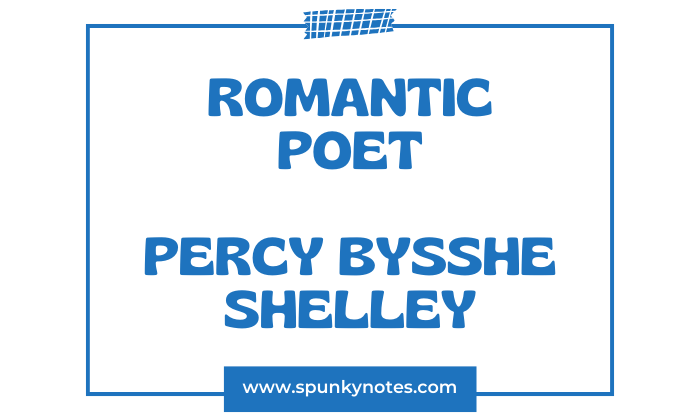
Q. Discuss Percy Bysshe Shelley as a Romantic poet.
Percy Bysshe Shelley is considered a later Romantic poet. Along with Lord Byron and John Keats, he belonged to the second generation of Romantic poets.
His work, which emerged in the early 19th century, followed the initial wave of Romanticism led by poets like William Wordsworth and Samuel Taylor Coleridge.
Percy Bysshe Shelley as a Romantic Poet
He is a Romantic poet because his works show several characteristics of Romanticism:
- Personal Experience
- Love for Nature
- Idealism
- Critique of Political Norms
- Innovative Style and Form
- Mysticism and Supernatural
1- Personal Experience
Percy Bysshe Shelley’s poetry often reflects his emotions and experiences, making these elements central to his work as a Romantic poet. In his famous poem “Ode to West Wind,” Shelley expresses a deep personal connection with the forces of nature, which mirrors his emotional state.
If I were a dead leaf thou mightest bear;
If I were a swift cloud to fly with thee;
A wave to pant beneath thy power, and share.
Shelley wishes to be as free and powerful as the West Wind, symbolizing his desire for liberation and transformation. This poem shows how Shelley uses his longing for change and impact in the world to drive the emotional core of his writing.
Similarly, in “Stanzas Written in Dejection, Near Naples,” Shelley shares his feelings of sadness and isolation:
The sun is warm, the sky is clear,
The waves are dancing fast and bright.
Despite the beauty around him, Shelley feels disconnected and lonely, showcasing the Romantic focus on individual emotional experience in contrast to the external world.
These examples highlight how Shelley’s story is deeply intertwined with his personal feelings and life experiences.
2- Love for Nature
Percy Bysshe Shelley’s appreciation for nature is evident throughout his poetry, reflecting a fundamental characteristic of Romantic poets. In “Mont Blanc,” Shelley pays tribute to the awe-inspiring presence of the natural landscape:
The everlasting universe of things
Flows through the mind, and rolls its rapid waves,
Now dark—now glittering—now reflecting gloom.
Here, the mountain is not just a physical presence but also a profound influence on the human mind and spirit. This interaction between the natural world and human perception shows nature’s beauty.
Additionally, in “To a Skylark,” Shelley admires the bird’s effortless connection with the natural world, describing it as a “blithe Spirit” who is
Higher still and higher
From the earth thou springest
Like a cloud of fire.
The skylark’s song transcends the mundane realities of the world and represents the purity and sublime beauty of nature that Shelley held in high esteem.
Through these poems, Shelley not only highlights nature’s beauty but also its deep, spiritual significance, which was a central theme in Romantic literature.
3- Idealism
Percy Bysshe Shelley was marked by a strong idealism, particularly evident in his visionary outlook on social and personal reform. In Promethe’s Unbound, Shelley articulates a vision for human potential and freedom.
To suffer woes which Hope thinks infinite;
To forgive wrongs darker than death or night;
To defy Power, which seems omnipotent.
Prometheus symbolizes the triumph of human will and kindness over suffering and tyranny, embodying Shelley’s hope for a better future.
Another clear example of Shelley’s idealism is in “Ode to the West Wind,” where he calls on the wind.
Scatter, as from an unextinguished hearth
Ashes and sparks, my words among mankind!
It clearly expresses his desire to inspire change and revolution through his words, showing his belief in the power of poetry to transform society.
Shelley consistently expresses a hopeful vision for humanity in his poetry. His belief in the power of love and imagination to overcome oppression and despair aligns with the Romantic emphasis on personal and societal improvement.
4- Critique of Social and Political Norms
Percy Bysshe Shelley frequently challenges social and political norms, reflecting his engagement with the critical issues of his time. In “England in 1819,” Shelley clearly portrays the societal conditions in England.
An old, mad, blind, despised, and dying King;
Princes, the dregs of their dull race, who flow
Through public scorn mud from a muddy spring.
This poem directly criticizes the monarchy and the government, reflecting Shelley’s disapproval of their corrupt and oppressive practices.
Similarly, in “The Mask of Anarchy,” Shelley responds to the Peterloo Massacre of 1819, where peaceful protesters advocating for reform were killed or injured by government forces.
I met Murder on the way
He had a mask like Castlereagh,
He directly accused specific political figures of brutality. Through these works, Shelley not only critiques the existing political structures but also encourages resistance and action against injustice.
His poetry serves as a call for reform and a voice against the oppression of ordinary people, showcasing his deep commitment to political and social change.
5- Innovation in Style and Form
Percy Bysshe Shelley is recognized for his innovative approach to style and form in poetry, which set him apart as a pioneering figure within the Romantic movement. One notable example is his use of the terza rima rhyme scheme in “Ode to the West Wind.”
Due to its complexity, this challenging form, consisting of interlocking triplets (ABA BCB CDC, etc.), is rare in English poetry. Yet, Shelley mastered it to enhance the poem’s flowing, wind-like movement:
O wild West Wind, thou breath of Autumn’s being,
Thou, from whose unseen presence the leaves dead
Are driven, like ghosts from an enchanter fleeing.
Furthermore, Shelley’s drama “Prometheus Unbound” demonstrates his experimental narrative form, which breaks from traditional structures to allow for a more expressive and philosophical exploration of themes.
This work does not adhere to conventional plot development and instead focuses on the symbolic and thematic representations of human struggle and potential.
Through such innovations, Shelley expanded the possibilities of poetic expression and contributed significantly to developing Romantic literature. Moreover, it emphasizes creativity and formal experimentation.
6- Mysticism and the Supernatural
Percy Bysshe Shelley often used mysticism and supernatural elements in his poetry. This allowed him to discuss big philosophical and existential questions in an abstract way.
In his poem “The Witch of Atlas,” Shelley creates a mystical character, the Witch, who uses her supernatural powers to navigate and influence the world around her.
Before those cruel Twins, whom at one birth
Incestuous Change bore to her father Time,
Error and Truth, had hunted from the Earth
All those bright natures which adorned its prime,
And left us nothing to believe in, worth
The pains of putting into learnèd rhyme,
A Lady Witch there lived on Atlas’ mountain
Within a cavern by a secret fountain
This portrayal enhances the mystical quality of his work and illustrates his fascination with unseen forces and mythical beings.
In “Adonais,” an elegy dedicated to John Keats, Percy Bysshe Shelley incorporates mysticism as he reflects on death.
He is made one with Nature: there is heard
His voice in all her music, from the moan
Of thunder, to the song of night’s sweet bird.
The lines suggest that Keats has transcended his physical death and become part of the natural world. Shelley presents the idea that Keats continues to exist in nature’s surroundings.
This depiction embodies the Romantic view that the soul can merge with the natural world in a mystical union. It illustrates a more profound spiritual continuity that persists beyond the physical existence.
Shelley uses these mystical ideas to convey that death might be a transformation rather than an end.
Conclusion
In conclusion, Percy Bysshe Shelley exemplifies the Romantic poet through his profound engagement with personal emotion, nature, idealism, societal critique, stylistic innovation, and mystical themes.
His works reflect a strong connection with the natural world and a committed stance against social injustice, expressed through innovative poetic forms.
Shelley’s integration of the supernatural further underscores his Romantic qualities, blending the mystical with the human experience.

